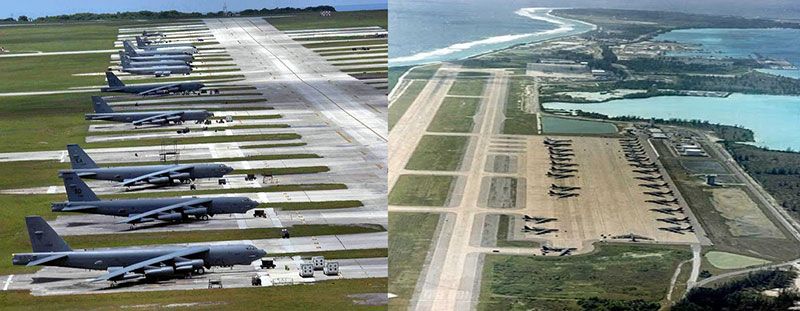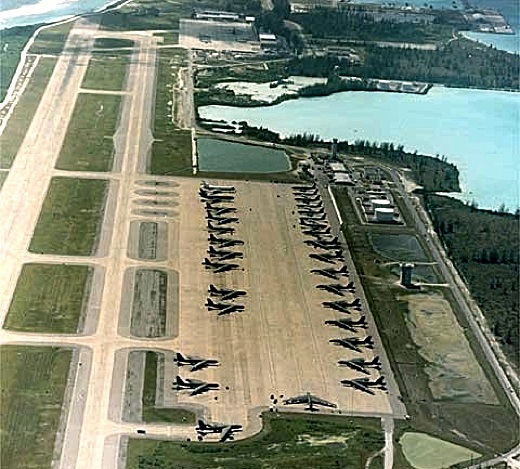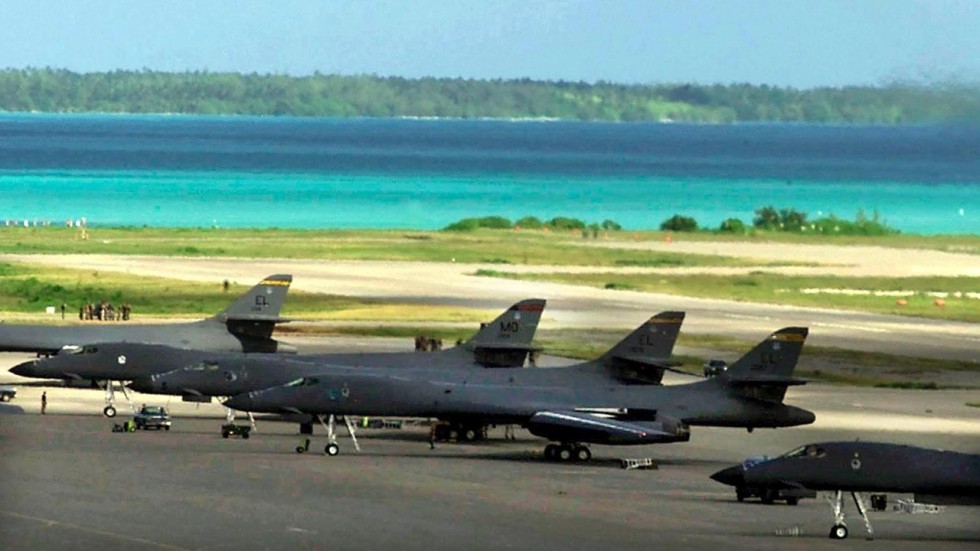
A growing movement is pushing back
against long-held orthodoxy,
arguing that it’s time to abandon
these outposts and bring the troops home
Tyler McBrien / Foreign Policy
(May 16, 2023) — Liseby Elysé was born in 1953 on Peros Banhos, an island in the Chagos Archipelago. As she tells it, life was good on her Indian Ocean “paradise island”:
Everyone had a job, his family, and his culture. But all that we ate was fresh food. Ships which came from Mauritius brought all our goods. We received our groceries. We received all that we needed. We did not lack anything. In Chagos, everyone lived a happy life.
That is, until Western militaries came to town.
In his book The Last Colony: A Tale of Exile, Justice, and Britain’s Colonial Legacy, Philippe Sands tells the story of how, in the 1960s and 1970s, the United Kingdom and the United States forcefully expelled the Chagossian people from their ancestral homeland. Almost overnight, an administrator told Elysé and everyone she knew that they had to vacate their houses, leave most of their belongings, and board a ship to faraway Mauritius and elsewhere, beginning a perilous journey often crammed at the bottom of boats “like animals,” in Elysé’s words.
In February, Human Rights Watch released a report condemning these actions as a crime against humanity, marking the first time that the group has laid such a charge at the door of the trans-Atlantic nations. Though that particular crime has yet to be litigated — if it ever will — the motive was clear: to make way for the construction of a US military base on the Chagossian island of Diego Garcia.

An Empire of Bases
Over the past century, stationing troops at overseas military installations like Diego Garcia has become a cornerstone of US foreign and defense policy. Today, the United States has more overseas military bases than every other country combined; its estimated 750 bases spread across 80 or more countries and constitute 75 to 85 percent of the world’s total overseas military bases — likely more than any other people, nation, or empire in history. A
nd as anti-China consensus hardens within the US political system and China builds up its own military presence in the Pacific and elsewhere, many believe that the strategy of overseas basing is more important than ever before.
But as the Chagossian experience demonstrates, this model is not without its costs — not only moral but economic, political, and strategic, as well. Despite being one of the most well-entrenched orthodoxies of US national security strategy, it may well be time for change.
A growing movement argues that rather than keeping the barbarians at the gate, the gates themselves have drawn the United States into reckless and unpopular conflicts, tempting policymakers into knee-jerk military responses rather than diplomatic ones, and provoke enemies rather than deter them. After decades of consensus, activists, scholars, and veterans are now pushing back against what they see as a geopolitical misstep, arguing that it’s time to abandon these long-held outposts and bring the troops home.

The Misstep of Forward Deployment
Since the Cold War, advocates of a forward-deployed posture claim that these bases deter enemies, reassure allies, and help the US military respond rapidly in times of crisis. Despite major advances in military technology in the past few decades, wars cannot be fought entirely from a distance.
Having a physical presence near potential zones of conflict is still valuable for “signaling not only the capability but, more importantly, the political will to fight in ways long range systems cannot,” political scientist Raphael S. Cohen wrote in 2021. Essentially, proponents of the status quo argue that there’s no replacing boots on the ground.
Although many presidents have sought to downsize the US military presence overseas in certain respects, this orthodoxy has changed little since the 1940s, despite the radical transformation of warfare and geopolitics since then.
Gen. Mark Milley, the chairman of the US Joint Chiefs of Staff, said as much himself in December 2020, when he remarked that the United States has “too much infrastructure overseas and too much permanent infrastructure,” characterizing many bases abroad as “derivative of where World War II ended.” As such, many no longer find the major arguments for this strategy compelling.
Instead of deterring enemies, US overseas bases can often provoke them. Just in March, the United States launched retaliatory airstrikes against Iranian-affiliated targets in Syria after a coalition base came under attack, which led to further attacks on US facilities just a day later. One American was killed and six more were wounded as a result.
To be fair, blaming bases as the sole provocation for attacks is irresponsible. And proving that a forward-deployed posture deters enemies is as difficult as finding the dog that didn’t bark. But the other justifications for this strategy aren’t entirely compelling either.
Overseas bases can indeed reassure allies, but in some cases, this strategy may work too well and risks making allies complacent in their own defense postures, content to free-ride off the United States’ largesse with little incentive to spend more on their own capabilities.
Unwelcomed Neighbors
In other cases, the backlash is more pronounced. Rather than providing reassurance, a US military presence can stoke resentment among local populations and their leaders, alienating the allies that bases were intended to reassure. Labor violations, criminal conduct by US soldiers, and violations of sovereignty that occur at or near US military bases can jeopardize delicate diplomatic relationships and fuel anti-US movements among locals.
Osama bin Laden famously cited the presence of US troops on foreign soil as one motivation for the 9/11 attacks. In November 2002, he wrote, “Your forces occupy our countries; you spread your military bases throughout them.”
More recently, Okinawa Gov. Denny Tamaki traveled to Washington, DC, to lobby Rep. Alexandria Ocasio-Cortez and other lawmakers against the construction of a new US air base and for a reduced US troop presence in his prefecture. Tamaki said the new base would place a burden on the local population, make them a target for attack, and violate Japan’s constitutional provision against the use of military force.
Many other protests have occurred across the US empire of bases. This hesitation isn’t unique. By one count, since World War II, local populations in more than 30 countries have taken to the streets to protest the US military presence in their backyards.
Even in an age of greater air power and advancing technology, overseas bases are still admittedly advantageous for rapidly responding to crises, but that’s not necessarily a good thing. For the Cato Institute’s John Glaser, US leaders’ easy access to bases makes it too easy to engage in warfare. It would be strategically better to deny them these tools of quick war and place obstacles in their way, such as public debate or a congressional force authorization vote, to avoid drawing the military into more unpopular, illegal interventions.
Andrew Bacevich, the chairman of the board at the Quincy Institute for Responsible Statecraft, emphasized this to me over email: “A global military presence tends to underwrite a penchant for ill-advised interventionism abroad. Put simply, a more modest global posture might underwrite greater restraint.”
To be sure, few anti-basing advocates would call for a complete abandonment of overseas outposts. But even a modest drawback could allow for the realignment of the US force posture to better match the nature and location of current threats — a priority called for by both the Trump and Biden administrations’ National Defense Strategies. According to Becca Wasser, a senior fellow at the Center for a New American Security, a fruitful place to start paring back would be the enormous US military infrastructure on the Arabian Peninsula and in the Persian Gulf.
Political scientist Neta C. Crawford estimates that the US military presence in the Gulf costs $5 billion to $50 billion a year to maintain. In The Pentagon, Climate Change, and War: Charting the Rise and Fall of US Military Emissions, she writes, the “political and military costs of defending access to Persian Gulf oil are very high, and probably not worth it since the risks of hostile takeover are low and the continued US presence in the gulf generates political resistance among the populations of those states.”
Closing overseas bases won’t be easy. As Milley said in his December 2020 remarks, “Frankly, there’s not a lot of enthusiasm to do what I just said, but I do think that’s necessary.” Wasser recently noted that force posture is “sticky” and, once established, a path dependency develops that can be hard to break.
At their core, permanent overseas bases represent a formidable sunk cost, and in the short term, it’s hard to imagine accruing the political and bureaucratic will for this massive undertaking. But US presidents have closed overseas bases in the past, so it doesn’t take much imagination to think that it could happen again.
Ending or even drawing back this presence will no doubt be difficult. But for the United States, letting go of its empire of bases is not only the moral choice but the strategic one, too.
Tyler McBrien is the managing editor of Lawfare. Previously, he worked as an editor at the Council on Foreign Relations and served as a Princeton in Africa fellow in South Africa. Twitter: @TylerMcBrien
Posted in accordance with Title 17, Section 107, US Code, for noncommercial, educational purposes.
